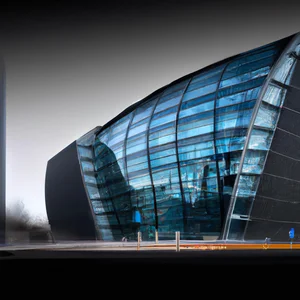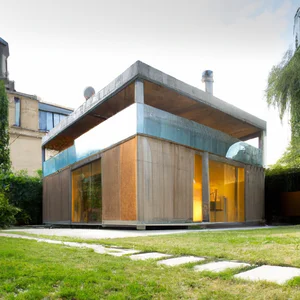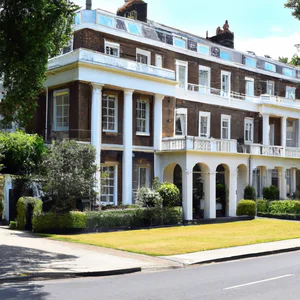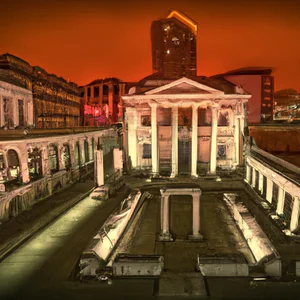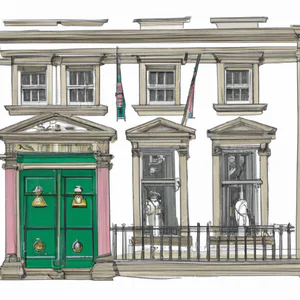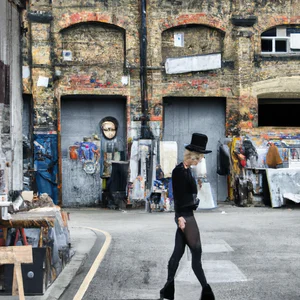Book your experience
Somerset House: Neoclassicism and contemporary art on the banks of the Thames
Somerset House: where neoclassicism meets contemporary art on the banks of the Thames
So, let’s talk about Somerset House, a place that, in my opinion, is truly fascinating! Imagine a large palace standing right on the banks of the Thames. It’s as if it has seen centuries of history, yet manages to remain fresh and modern. I went there a couple of times and, wow, the atmosphere is something unique!
Here, to give you an idea, Somerset House is an incredible mix of architectural styles. On the one hand you have that neoclassical touch, with columns and facades that make you feel like you’ve stepped back in time. On the other hand, there are spaces dedicated to contemporary art that make you think, “What the hell is going on here?” It’s like a meeting between the past and the present, and sometimes it almost seems as if the artists are in dialogue with history.
For example, while walking through the courtyards, I came across an installation that looked like a work of modern art, but was, in fact, somehow inspired by classical elements. It was a bit like seeing a tango between the old and the new. I’m not sure, but I think this fusion can reveal a lot about how art evolves and adapts to modern times.
And then, there’s that famous water glacier that forms in winter, where everyone goes to skate. It’s a bit like a carousel of emotions! You see families, friends, couples… everyone having a great time. It makes you feel like you’re part of something big, even if you’re just sliding on the ice.
In short, Somerset House is not just a place to visit, but an experience to live. If you happen to find yourself in London, drop by. It may not change your life, but it will certainly give you some smiles and a bit of beauty. And who knows, you too might discover some piece of history you didn’t know!
Discover the neoclassical architecture of Somerset House
Walking along the banks of the Thames, I found myself in front of an imposing white facade that seemed to tell stories of bygone eras. Somerset House, with its majestic neoclassical architecture, is not just a simple building: it is a living monument that has welcomed visitors for over two centuries. The first time I set foot in this extraordinary space, I immediately felt a sense of grandeur and history that conveys a deep respect for the principles of neoclassicism, in particular symmetry and harmony.
Architecture that speaks
Built between 1776 and 1796, Somerset House was designed by architect ** William Chambers **, who blended classically inspired elements with the innovation of his time. The Doric columns and large terraces offer an idea of opulence and serenity, while the vast central courtyard is an invitation to pause and contemplate. The architectural details, such as the elegant statues and decorative friezes, tell stories of mythology and culture, making each visit an immersive experience.
Practical information: Today, Somerset House hosts a series of exhibitions and events celebrating contemporary art, but don’t forget to take a moment to appreciate the architectural beauty. Admission is free to the courtyard and many events, while exhibits may require a ticket. It is advisable to check the official [Somerset House] website (https://www.somersethouse.org.uk/) for updates and information on timetables.
An insider tip
If you want a unique experience, try to visit Somerset House during sunset. The sun’s rays hitting the facade create golden reflections that make the atmosphere almost magical. Also, don’t forget to explore the secret courtyard, a hidden corner that offers an intimate interpretation of the grandeur of neoclassical architecture, away from the crowds.
The cultural impact
Somerset House is not only an example of neoclassical architecture, but has also played a significant role in British culture. Originally built as a residence for nobles, it has over time become a vital cultural centre, contributing to significant events and artistic initiatives that have influenced the London scene. Its presence continues to inspire artists and architects, making it a symbol of creativity and innovation.
Sustainability and responsibility
In an age where sustainability is key, Somerset House is committed to promoting responsible practices. The architecture itself, with its historic structure, is an example of reuse and valorization of heritage, avoiding the construction of new buildings that could damage the surrounding environment.
An experience not to be missed
During your visit, don’t miss the opportunity to participate in one of the creative workshops or artistic events offered. These moments not only celebrate contemporary art, but will allow you to immerse yourself in London’s cultural community.
A myth to dispel
A common misconception is that Somerset House is just a venue for exclusive events and expensive art exhibitions. In reality, it offers many activities that are free and accessible to all, making culture a collective heritage rather than a privilege.
Concluding my experience at Somerset House, I asked myself: how can a place so rich in history continue to evolve and remain relevant in the contemporary world? The answer seems to lie in its ability to unite past and present in an architectural embrace that continues to surprise and inspire.
Discover the neoclassical architecture of Somerset House
A personal experience
I still remember the moment I crossed the threshold of Somerset House for the first time. My steps stopped in front of the majestic neoclassical facade, with its imposing columns and architectural details that tell stories of a bygone era. As I strolled through its courtyard, I almost felt I could hear the conversations of the artists and thinkers who once animated these spaces. Somerset House is not just a building; it is a stage where contemporary art merges with the grandeur of the past.
A refuge for contemporary art
Somerset House is more than just an example of neoclassical architecture; it is a pulsating center of culture and creativity. Contemporary art exhibitions are one of the most engaging experiences this place has to offer. Each year, the institution hosts a variety of exhibitions ranging from photography to sculpture, creating a bridge between historical heritage and today’s artistic vanguards. Recently, the exhibition “Under the Skin” captured the attention of visitors, exploring the relationship between identity and the body through provocative installations.
For updated information on current exhibitions, I recommend you visit the official Somerset House website or follow their Instagram account, where special events and initiatives are shared.
Unconventional advice
If you want a unique experience, I recommend taking one of the guided tours focused on contemporary works of art. These visits offer an in-depth look behind the scenes, with the chance to interact directly with curators and artists. It’s a way to understand not only the art itself, but also the context in which it was created.
Cultural and historical impact
Somerset House has a fascinating history, dating back to the 18th century, when it was designed as a residence for nobles. Its transformation into a cultural hub has had a significant impact on London’s arts scene, helping to make the capital a crossroads for artists from around the world. This place not only celebrates the past, but constantly reinterprets it, making it relevant to new generations.
Sustainability and responsibility
In an age where sustainability is crucial, Somerset House is actively committed to responsible practices. Contemporary art exhibitions often address environmental issues, encouraging visitors to reflect on their impact on the world. Furthermore, the organization promotes eco-friendly events and collaborates with artists who use recycled materials in their works.
Immersion in the atmosphere
Walking through the corridors of Somerset House, let yourself be enveloped by the beauty of its spaces. The play of light filtering through the windows, the scent of coffee coming from the in-house café, and the sound of visitors’ laughter create a vibrant and welcoming atmosphere. Every corner invites you to stop and contemplate, making each visit an unforgettable experience.
Activities to try
Don’t miss the chance to take part in one of the creative workshops that frequently take place within Somerset House. These events not only offer the opportunity to learn new artistic techniques, but also foster a sense of community among participants.
Myths to dispel
A common misconception is that Somerset House is an exclusive place, accessible only to a few. In reality, it is an environment open to all, with many free or low-cost activities. The beauty of this space is that it invites anyone to explore and appreciate art, without barriers.
Final reflection
Somerset House is a place where the past and present are intertwined in an extraordinary way. Have you ever wondered how architecture influences our perception of art? The next time you visit this extraordinary cultural center, take a moment to reflect on how yesterday’s stories continue to inspire today’s creations.
Seasonal Events: Magic on the Thames
When I think of the seasonal events at Somerset House, my mind goes back to a cold December evening when I attended one of the famous ice skating rinks. Illuminated by thousands of twinkling lights, the majestic neoclassical architecture stood like a stage for a winter fairy tale. The air was crisp, filled with the sounds of laughter and sliding on ice, while the scents of mulled wine and roasted chestnuts danced in the air. This is the power of seasonal events: they transform an already magical space into an unforgettable experience.
A calendar full of events
Somerset House hosts a calendar of events ranging from winter celebrations to summer festivals. During the summer, the courtyard comes alive with outdoor concerts and film screenings, creating a vibrant atmosphere that attracts visitors from all corners of London. For art lovers, don’t miss the London Design Biennale, which transforms interior spaces into an explosion of creativity and innovation. For up-to-date information, it is always useful to consult the official Somerset House website or social media pages, where events and activities are published in real time.
An insider tip
A little-known tip is to visit Somerset House during the blue hour, that magical time between day and night. The light that filters through the columns and the courtyard becomes incredibly evocative, and the outdoor events seem to gain an almost ethereal dimension. Many visitors don’t realize that, in addition to the ice rink in winter, there are often craft markets and live performances that make each visit unique.
A profound cultural impact
These events are not just a pastime; have a significant cultural impact. They create a sense of community, bringing together people of different backgrounds and age groups, all drawn to the beauty and history of Somerset House. The structure itself, once a royal palace, has always played a central role in London’s cultural life, and its seasonal events continue this tradition of celebration and inclusiveness.
Sustainability and responsibility
Somerset House is also committed to sustainable tourism practices. During the events, local and sustainable foods are promoted, and the use of eco-friendly transport to reach the site is encouraged. Taking part in environmentally friendly events is a way to experience London responsibly, helping to preserve the beauty of these places for future generations.
An experience not to be missed
If you’re visiting London, be sure to book an evening for one of the seasonal events at Somerset House. Whether it’s an outdoor movie night or a concert, the atmosphere is always electrifying. Often, there are children’s activities too, making the experience suitable for the whole family.
Myths and misconceptions
A common misconception is that events at Somerset House are exclusive or expensive. In fact, there are many accessible options and even free events, such as concerts and festivals. Don’t let the idea of a high cost stop you from exploring what this wonderful space has to offer.
Final reflection
Every time I visit Somerset House during a seasonal event, I am reminded of the beauty of shared experiences. What is your favorite event in a city? We invite you to consider how participating in cultural events can enrich your travel experience and bring you closer to a community, turning a simple visit into an indelible memory.
A hidden corner: the secret courtyard
A personal experience
I still remember the moment I discovered the secret courtyard of Somerset House. It was a sunny day, and after exploring the crowded exhibition halls, I distanced myself from the crowds. Out of curiosity, I opened a door that opened onto a dimly lit corridor. What I found was a corner of tranquility, a lovely courtyard surrounded by neoclassical architecture, with the sound of water flowing from a central fountain. It was as if time had stopped, and in that moment I understood that this place hid a unique beauty, far from the frenzy of city life.
Practical information
The secret courtyard is accessible during Somerset House opening hours, usually 10am to 6pm, but it’s always a good idea to check the official website for any changes. This space, often overlooked by visitors, is an ideal place for a refreshing break, where you can sit on the benches and enjoy the view. Don’t forget to bring a good read with you or simply let your thoughts carry you away as you observe the architectural details that surround you.
An insider tip
A little-known tip: if you are at the secret courtyard during the summer, try to visit it at lunch time. Often, a local artisans’ market is set up offering fresh products and typical British cuisine. It’s a fantastic opportunity to savor culinary delights while enjoying the beauty of the courtyard.
Cultural and historical impact
The secret courtyard is not just a haven of peace; it is also a place that tells stories of a fascinating past. Originally built in the 18th century, Somerset House was a royal residence and later an important cultural centre. This courtyard, in particular, has witnessed significant historical events and welcomed artists and thinkers who contributed to the cultural life of London. Its architectural beauty represents a fusion of styles and periods, making it a cultural landmark for the city.
Sustainability and responsible practices
Somerset House is also committed to sustainability. The courtyard is used for events that promote environmental awareness and community, such as eco-markets and art activities that encourage interaction among visitors. This approach not only enriches the visitor experience, but also strengthens the link between art and culture and environmental responsibility.
Immersion in the atmosphere
Imagine sitting in the courtyard, surrounded by elegant columns and statues, while the sun filters through the trees. The sounds of the city seem to fade away, replaced by the gentle murmur of water and birdsong. This is a place where every corner tells a story, where art and nature intertwine in a serene embrace.
An activity worth trying
For a truly immersive experience, join one of the art workshops that take place in the courtyard during the summer. These events will not only allow you to explore your creativity, but will also give you the chance to meet local artists and other art enthusiasts.
Myths and misconceptions
A common misconception is that the secret courtyard is a place that is difficult to find or accessible only to a select few. In fact, it’s open to everyone and represents a perfect opportunity to discover a lesser-known side of Somerset House. Don’t miss this hidden gem!
Final reflection
Every time I visit the secret courtyard, I ask myself: how many other hidden wonders are there in London just waiting to be discovered? This corner of tranquility is just one example of how the city can surprise and enchant, inviting us to stop, breathe and appreciate the beauty that surrounds us.
Fascinating history: from palace to cultural center
Walking along the Thames, the view of Somerset House is like a blast from the past. I remember the moment I walked through its imposing doors for the first time, fascinated by the majesty of the neoclassical façade. That day, I found myself in a place that, for centuries, has hosted royalty, artists and innovators. Perhaps not everyone knows that Somerset House, originally built in the 18th century as an aristocratic residence, has undergone an extraordinary metamorphosis from a private palace to a cultural hub of London.
A journey through time
Today, Somerset House is a dynamic cultural centre, hosting contemporary art exhibitions, events and festivals that attract visitors from all over the world. Its history is full of significant events: from its use as the headquarters of the British Royal Navy during the Second World War, to its transformation into a vibrant space for art and creativity.
For those who want to find out more, I recommend visiting the Somerset House Trust, where you can find updated information on current events and exhibitions. Their web page is an excellent starting point for planning your visit and discovering upcoming initiatives.
An insider tip
If you want an experience that many overlook, try taking part in a creative workshop offered by Somerset House. Often, these events are open to all and provide the opportunity to immerse yourself in artistic techniques, from drawing to photography, guided by industry experts. It’s a unique way to explore the history of art in the very venue that hosted it.
Cultural heritage
Somerset House is not just a building; it is a symbol of London’s culture and creativity. Its evolution from aristocratic residence to cultural center reflects the social and artistic changes that have shaped the city. Every corner of this space tells stories of artists and thinkers, contributing to a vibrant cultural landscape that continues to evolve.
Sustainability and responsibility
In an age where sustainability is crucial, Somerset House is committed to reducing its environmental impact. Through initiatives such as eco-sustainable events and awareness programmes, the cultural center promotes responsible tourism, encouraging visitors to consider the impact of their actions.
An experience not to be missed
Don’t forget to get lost in the secret courtyard of Somerset House, a quiet corner where time seems to have stopped. Here, you can sit and reflect, surrounded by architectural beauty that invites contemplation.
Many think that Somerset House is just an art gallery, but it is much more: it is a place of meeting, creativity and inspiration. It’s an opportunity to connect with history and art in ways that go beyond simple observation.
A final reflection
After visiting Somerset House, I asked myself: how can we all help preserve the beauty and creativity of spaces like this? The history of Somerset House invites us to reflect on the importance of supporting culture and art, so that may they continue to prosper into the future.
Sustainability at Somerset House: a real commitment
A personal experience of connection
I clearly remember the moment I walked through the doors of Somerset House for the first time. The majestic neoclassical architecture, with its imposing columns and its sunny courtyard, welcomed me in an embrace of history and culture. But what really caught my attention was a small exhibit dedicated to sustainability. Art and environment were intertwined in a dialogue that made me reflect: it’s not just about enjoying beauty, but about taking care of our world.
Practical and up-to-date information
Somerset House is a living example of commitment to sustainability. Since 2021, the institution has adopted a series of green measures, including the use of renewable energy to power its exhibition spaces and the implementation of waste management practices to reduce environmental impact. According to the official Somerset House website, over 50% of the materials used for the exhibitions come from recycled or sustainable sources.
A little-known tip
Here’s a tip that few people know: when visiting, don’t forget to explore Somerset Garden. This hidden green corner is not only a place to relax, but is also home to a variety of local plants, contributing to the biodiversity of the area. Walking here offers not only a moment of tranquility, but also a direct connection with the sustainable practices of the place.
Cultural and historical impact
Somerset House is not just a cultural centre; it is a symbol of how history and innovation can coexist. Originally built in the 18th century as an aristocratic residence, today it represents a beacon of creativity and environmental responsibility. Its evolution from palace to cultural hub reflects a profound change in the perception of art and community, underlining the importance of a responsible approach towards our planet.
Sustainable tourism practices
When visiting Somerset House, consider using public transport to reach the property. London offers an excellent public transport system, which reduces carbon emissions and contributes to more responsible tourism. Furthermore, many of the activities taking place here are designed to engage the local community, promoting the social inclusion that is at the heart of Somerset House’s mission.
Vivid and engaging atmosphere
Imagine walking along the sweeping staircases of Somerset House, the sun reflecting off the white surfaces, as artists and creatives gather to discuss innovative ideas. The atmosphere is vibrant, a mix of history and modernity, where the past meets a greener and more responsible future. Every corner tells a story, every display a message of hope for a better world.
An activity worth trying
Don’t miss the chance to take part in one of the creative workshops that take place regularly at Somerset House. These events not only stimulate creativity, but often focus on sustainable materials, offering a hands-on experience that combines art and environmental awareness.
Address common myths
A common misconception is that the initiatives of sustainability are expensive or difficult to implement. In fact, Somerset House demonstrates that it is possible to integrate ecological practices without compromising artistic value. Exhibitions and events can be beautiful and, at the same time, environmentally friendly.
A final reflection
As you leave Somerset House, take a moment to reflect on what you have seen. How can you contribute to a more sustainable future in your daily life? In a world where art and nature can intertwine, perhaps it’s time to consider that every visit can be a step towards real change.
Art and community: creative workshops for everyone
A transformative experience
I vividly remember my first visit to Somerset House, where the scent of fresh paint mingled with the crisp London air. As I approached the courtyard, a lively crowd of people of all ages engaged in a pottery workshop. Not just art, but a true celebration of the community. This is exactly what Somerset House represents: a place where art meets people, where creativity is within everyone’s reach.
Workshops for every talent
Somerset House offers a variety of creative workshops, designed to engage and inspire both beginners and experienced artists. From painting to sculpture to photography, the opportunities for artistic expression are endless. You can find updated information on ongoing activities by visiting the official Somerset House website or checking their social channels, where they share special events and thematic workshops.
An insider tip
If you want a truly unique experience, try taking part in a lettering or calligraphy workshop. Not only will you learn artistic techniques, but you will also have the opportunity to create a personalized piece to take home. This workshop is often less crowded and will allow you to interact with local artists, discovering anecdotes and stories that make Somerset House a special place.
History and cultural impact
Somerset House, once an aristocratic residence, is now a cultural landmark that reflects the diversity and creativity of the London community. The workshops not only encourage individual creativity, but also promote social inclusion, giving a voice to anyone who wishes to express themselves. These creative spaces are central to London’s cultural vitality and demonstrate the importance of open access to art.
Sustainable tourism practices
Somerset House is committed to responsible and sustainable tourism. By participating in the workshops, you not only support local artists, but you will also contribute to eco-friendly artistic practices, thanks to the use of recycled materials and low environmental impact techniques.
Soak up the atmosphere
Imagine yourself mixing bright colors on your palette, surrounded by other enthusiasts, while music and laughter fill the air. The feeling of belonging that you feel in these workshops is palpable and makes each creation unique and personal.
An unmissable activity
Don’t miss the opportunity to sign up for one of Somerset House’s workshops; it’s a fantastic way to immerse yourself in local culture and take home a handmade souvenir. Please see the events calendar for up-to-date dates and book in advance as sessions can fill up quickly.
Myths to dispel
A common misconception is that art is only for those with natural talent. In fact, Somerset House workshops are designed for everyone, regardless of artistic ability. Don’t be afraid to get your hands dirty and let yourself go to creativity!
Final reflection
Somerset House is not just a cultural centre; it is a place where art intertwines with everyday life, creating opportunities to express oneself and connect with others. Next time you are in London, ask yourself: what personal story could I tell through art?
Local restaurants: taste London cuisine
When I visited Somerset House for the first time, my mind was full of artistic expectations. However, what struck me most was the discovery of a restaurant overlooking the Thames, where the scent of dishes prepared with fresh, local ingredients mixed with the crisp air of the river. This gastronomic corner, The River Terrace, is not just a restaurant, but a real culinary stage that reflects the essence of London. Here, in the beating heart of the capital, local cuisine blends with international influences, bringing to the table dishes that tell stories of tradition and innovation.
A unique gastronomic experience
Located within the Somerset House complex, The River Terrace offers breathtaking views of the River Thames and historic neoclassical architecture. The menu varies according to the seasons, with dishes such as creamed cod and apple pie with vanilla ice cream, all prepared with ingredients sourced from London producers. If you want an authentic experience, I recommend trying the Sunday brunch, where you can enjoy a selection of dishes to share, while the sound of flowing water creates an enchanting atmosphere.
An insider tip
While many visitors focus on the art displays and architecture, few know that Somerset House also hosts a festive food market. This annual event, known as Somerset House Christmas Market, is an unmissable opportunity to enjoy local delicacies and purchase artisan products. Don’t forget to enjoy a glass of mulled wine while soaking in the twinkling lights that decorate the courtyard.
The cultural impact of gastronomy
London’s cuisine is a reflection of its cultural diversity, and Somerset House’s restaurants are a perfect example of this phenomenon. Offering dishes that mix culinary traditions from around the world, these spaces not only nourish the body, but also the soul, creating a dialogue between the different cultures that make up the city. Additionally, Somerset House restaurants are committed to sustainability, using organic ingredients and reducing food waste, an important step towards responsible tourism.
An activity not to be missed
After exploring the artistic wonders of Somerset House, take a break and book a table in the restaurant. Not only will you be able to enjoy London cuisine, but you will also have the opportunity to reflect on your artistic experience while enjoying the views over the Thames.
A common misconception
Many believe that high-quality cuisine is reserved only for luxury restaurants. However, Somerset House proves that it is possible to enjoy delicious food in an accessible and welcoming environment, without having to break the bank. Quality doesn’t necessarily have to mean a high price.
Final reflection
As you enjoy a meal at The River Terrace, consider how food and art can impact our lives. Which dish best represents your trip to London and how can cuisine contribute to your understanding of local culture? Next time you visit Somerset House, remember that each bite is an invitation to explore and celebrate the stories each dish has to tell.
Unique tip: visit at dawn for peace of mind
When I first set foot in Somerset House, it was a cold winter morning, and there I was, a little sleepy, but also curious. I decided to get up at dawn, attracted by the idea of exploring this iconic place before the world woke up. The early morning light danced on the waters of the Thames and the great neoclassical colonnades stood out against the sky that was colored pink and orange. In that moment, I felt like I was part of a living painting, a work of art slowly unfolding before my eyes.
A unique experience
Visiting Somerset House at dawn offers a unique experience. The tranquility that reigns is palpable; you can hear the sound of water flowing in the Thames, the rustling of leaves and occasionally the chirping of birds. While many tourists flock to the best-known spots during the day, in the morning you can stroll calmly, savoring every corner of this magnificent architectural complex. I recommend you bring a good camera with you: the morning light makes every shot extraordinary.
Practical information
Somerset House is located in the heart of London, easily accessible by tube. Opening hours may vary depending on the ongoing exhibitions, but generally the complex is accessible to the public from the early hours of the morning. Check the official [Somerset House] website (https://www.somersethouse.org.uk) for any special events or early openings.
An insider tip
Here’s a little-known tip: bring a thermos of tea or coffee! There’s nothing better than sipping a hot drink while watching the city come to life. It’s a small gesture that makes the experience even more special, and makes you feel like a real insider, away from the hustle and bustle of the crowd.
The cultural impact of Somerset House
Somerset House is not just an architectural monument; it is a cultural center that has hosted significant events over the centuries. Originally built as a residence in the 18th century, today it is a crossroads of art, history and innovation. The fusion of neoclassicism and contemporary art that can be felt here reflects the evolution of British culture, making it a place of great historical and cultural importance.
Sustainability and responsibility
In an age where sustainability is crucial, Somerset House is actively committed to promoting eco-friendly practices. Various initiatives have been implemented to reduce environmental impact, from the use of recycled materials in art installations to events that raise public awareness of sustainability. Visiting Somerset House is not only an aesthetic experience, but also an opportunity to reflect on our responsibilities to the planet.
An invitation to reflection
As you walk among the colonnades and watch the Thames flow placidly, ask yourself: what does art mean to me and how does it impact my daily life? Somerset House is a place that invites contemplation and discovery, and each visit can offer you new perspectives and food for thought. If you have ever thought about visiting London, don’t miss the opportunity to experience this magical corner in the morning. You may find that the true beauty of Somerset House reveals itself slowly, like the sunrise itself.
The Thames: Explore London’s riverside history
A personal experience along the river
I still remember my first walk along the Thames, one spring afternoon when the sun’s rays danced on the surface of the water. As I walked, I found myself surrounded by a mix of historic architecture and modern life. It was at that moment that I realized how steeped in history and culture this river is. Every bridge, every pier tells a story, and every ripple of the water seems to whisper secrets of the past.
Practical and up-to-date information
The Thames is not just a river; it is the beating heart of London, which stretches for 346 kilometres. For those who wish to explore this historic waterway, I recommend starting your journey at the London Eye and continuing towards the Tate Modern. Along the way, stop at various scenic spots, such as the Millennium Bridge, to appreciate the view. Boat companies, such as Thames Clippers, offer regular tours and are an excellent way to see the city from a different perspective.
An insider tip
A little-known tip is to take the time to explore lesser-known wharves along the river, like the St. Katharine Docks. Here, away from the crowds, you will find small cafes and boutiques that tell forgotten stories of merchants and sailors. This corner of London is perfect for a relaxing break, overlooking the harbour.
The cultural and historical impact
The Thames has always played a crucial role in the life of London. It has been a trade route, a natural border during conflicts and a symbol of resilience. Today, the river continues to be an important cultural artery, hosting festivals, concerts and events that celebrate the capital’s diversity and history. Its presence has also inspired artists, writers and musicians, making it a central element in British culture.
Sustainable tourism practices
In recent years, several sustainable tourism initiatives have taken hold along the river. Many tour operators now use electric boats to reduce environmental impact, while walks along its banks are encouraged as a way of exploring the city in a more eco-friendly way. Taking part in river clean events is a great way to connect with the community and help preserve the natural beauty of the River Thames.
An engaging atmosphere
Walking along the river, the sounds of the city mix with the murmur of the water. The sight of boats plying the river, pigeons chasing each other and people enjoying a picnic on the banks creates a vibrant and welcoming atmosphere. It is a place where the past and present intertwine seamlessly, inviting every visitor to discover a piece of London’s history.
An activity not to be missed
Don’t miss the chance to take a sunset cruise on the Thames. This experience not only offers breathtaking views of the illuminated city, but also allows you to hear fascinating stories about London’s river history from expert guides. It’s an unforgettable way to end the day.
Addressing the myths
A common myth is that the Thames is a dirty and polluted river. In fact, in recent decades, enormous progress has been made to improve water quality, so much so that the river has become a habitat for many species of fish and birds. Local businesses and environmental organizations are working tirelessly to keep this natural treasure clean.
A personal reflection
As I walked away from the river, with the sun setting on the horizon, I couldn’t help but think about how the Thames is more than just a waterway: it’s a living testament to London’s history and culture. What stories would you reveal to us if only you could talk? Next time you visit London, take a moment to listen to what the Thames has to say.

 Architecture and Design
Architecture and Design Cities and Regions
Cities and Regions Culture and History
Culture and History Events and Festivals
Events and Festivals Fashion and Shopping
Fashion and Shopping Food and Wine
Food and Wine Nature and Adventure
Nature and Adventure Unique Experiences
Unique Experiences


















